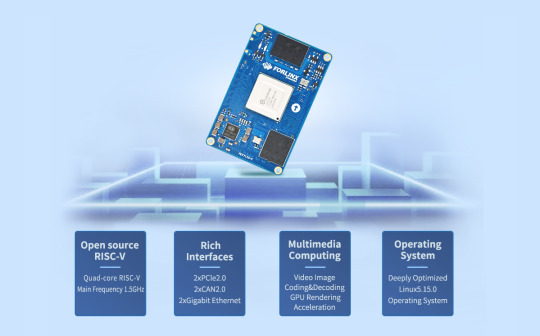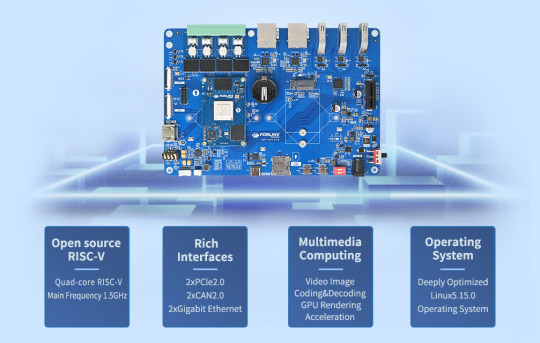#JH7110 processor
Explore tagged Tumblr posts
Text
Introduction of Forlinx Embedded's Upcoming SoM Based on RISC-V Architecture
In recent years, RISC-V has attracted a lot of attention because of its completely open source, free of charge, and free to modify without constraints. Under this background, Forlinx Embedded works together with a RISC-V processor manufacturer and launches FET7110-C SoM based on Jinghong(JH) 7110 processor!

The FET-JH7110-C SoM is designed and developed based on the JH7110 processor, with a process of 28 nm, open source RISC-V architecture, main frequency of 1.5 GHz, and integrated 4-core U74 architecture; It has powerful GPU processing capability and supports multi-lane video encoding and decoding, common functional interfaces such as 2xPCIe 2.0, 2xGigabit Ethernet, 2xCAN 2.0, etc. The SoM supports Linux 5.15.0 suitable for industrial vision-related application development.
In the future, Forlinx Embedded will take an active and open attitude in continuing to cooperate with more chip manufacturers and provide customers with more stable, reliable, and comprehensive intelligent control products!
Other Recommended Articles:
Originally published at www.forlinx.net.
0 notes
Text
Unveiling the innovative Forlinx FET7110-C System on Module!
🚀 With a powerful quad-core 1.5GHz RISC-V JH7110 processor, advanced GPU, and dynamic power control, it's tailor-made for demanding industrial vision applications like computer vision, deep learning, and graphics rendering.
Elevate your projects with cutting-edge technology!

0 notes
Text
Introducing the OK7110-C RISC-V Single Board Computer(SBC)/Development Board - Your Gateway to Enhanced Connectivity and Innovation. With versatile peripheral interfaces including HDMI, MIPI-DSI, camera, Ethernet, USB3.0, PCIe2.0, UART, RS485, CAN2.0, SPI, audio, TF card slot, 4G/5G, and more, this board empowers you to unleash the full potential of your projects.

Experience seamless integration, high-speed data transfer, and reliable communication, all in one compact and powerful development board.
Contact us for price
0 notes
Text
How to Convert MIPI Signal to LVDS Signal Using LT8912B on OK7110-C Single Board Computer?
This solution employs Lontium Semiconductor's LT8912B, which features a single MIPI D-PHY receiver with four data lanes, each running at speeds of 80Mbps to 1.5Gbps, with a maximum input bandwidth of 6Gbps.
LVDS has 1 clock lane and 4 data lanes for a maximum of 1.0 Gbps per data lane. The HDMI output supports the HDMI 1.4 standard, allowing for a maximum output of 60Hz at 1080p resolution with 8-bit color depth. The LT8912B does not support DDC and HDCP.
This article describes how to use LT8912B to convert MIPI to LVDS. The hardware implementation can involve directly designing the LT8912B chip onto the carrier board or designing an adapter board to connect LT812B to the OK7110-C development board.

Software modification method:
Create a script file test. Sh to write the register parameters of I2C of LT8912B chip (the parameter configuration in this article is based on an LVDS screen with single 8-lane, 1280X800 resolution, and GT928 touch chip, and the specific parameter configuration is mainly based on the actual screen parameters).



Place the test.sh script under /usr/bin/, or you can modify the name as you wish. Then, modify the path in the service configuration file.
vi /usr/lib/systemd/system/[email protected]
Note that a row has been addedExecStartPost=/usr/bin/test.sh &
Note that if the path is modified, the path in the added line needs to be matched /usr/bin/test.sh
[Service] Type=oneshot RemainAfterExit=yes ExecStart=/usr/lib/systemd/systemd-fsck %f ExecStartPost=/usr/bin/test.sh & TimeoutSec=0
Modify the device tree OK7110-C.dts

Originally published at www.forlinx.net.
0 notes
Text
RISC-V: An open, Flexible, and Innovative Processor Architecture Leading the Future
As technology develops rapidly, smart devices play an increasingly important role in our lives. Have you ever wondered why your smartphone, computer, and other smart devices can run various complex software and applications? This is all thanks to the powerful processor architecture. Today, we will take you into an eagerly anticipated processor architecture - RISC-V.
RISC-V originated from the University of California, Berkeley, and was created by a group of researchers including Andrew Waterman, Krste Asanović, and Yunsup Lee. Their vision is to break the closed design pattern of computer processors and provide an open and flexible instruction set architecture. Since its release RISC-V has received widespread attention in various fields and has become a highly praised architecture.

Advantages of RISC-V:
1. Openness and freedom: RISC-V’s open-source allows anyone to use and customize it for free, without paying patent royalties.
2. Modularity and customization: RISC-V’s design allows developers to choose different modules and create custom instruction sets that meet specific needs.
3. Technological innovation: RISC-V’s openness encourages technological innovation and attracts the participation of many companies and research institutions.
4. Wide range of application fields: RISC-V can be used for embedded systems, IoT devices, servers, high-performance computing and other fields.
RISC-V is an eagerly anticipated open-source instruction set architecture, with a wide range of application prospects. It represents the future direction of computer processor design, and its openness, freedom, and technological innovation make it have potential in multiple fields. To boost the development of RISC-V, Forlinx Embedded launched a new product - FET7110-C System on Module, which is the first product based on RISC-V architecture.

FET7110-C SoM is based on StarFive’s 64-bit high-performance quad-core RISC-V JH7110 processor design and development, with high performance, multi-function, low power consumption characteristics, CPU stable working frequency 1.5GHz, Coremark score of 5.09 CoreMark/MHz, performance better than Cortex-A55. 7110 uses IMG BXE-4-32 MC1 architecture, provides powerful GPU processing capability, supports multi-channel video encoding and decoding, and supports rich functional interfaces such as 2 PCIe2.0, 2 Gigabit Ethernet, and 2 CAN2.0, making its application scenarios more extensive.
In terms of power consumption, the FET7110-C SoM is divided into eight power domains that can be switched independently. By using software, the CPU frequency can be adjusted, allowing customers to dynamically control the power consumption according to different application scenarios.

FET7110-C SoM is a versatile board for all industries and can be used in many industries such as industrial intelligence, smart surveillance, commercial electronics, smart home and power and energy. After rigorous testing, the FET7110-C SoM can provide stable performance support for customers' high-end applications.
The emergence of RISC-V provides a new option. In the future, with the increasing demand for openness and customization, RISC-V is expected to continue to grow in different application fields. In particular, RISC-V is expected to gain more market share in embedded systems, IoT, education and research.
0 notes
Text
Forlinx Officially Launches RISC-V SoM Based on StarFive JH7110!
Forlinx has officially launched their latest System-on-Module, featuring the powerful StarFive JH7110 RISC-V chip. These versatile SoM and compatible carrier board are now available for order, catering to a wide range of applications including commercial, medical, and industrial automation.
Recently, a few embedded products have emerged utilizing the same processor, including the VisionFive 2, Pine64, and Milk-V Mars. However, the FET7110 SoM will be the first product from Forlinx to feature the integrated Jinghong 7110 processor. See the JH7110 block diagram for reference.
• JH7110 – 64-bit RISC-V, up to 1.5GHz (quad SiFive U74-RV64GC, up to 5.09 CoreMark/MHz)

JH7110 block diagram
The JH7110’s GPU integrates the IMG BXE-4-32 MC1 (up to 600MHz) which offers full support for mainstream APIs like OpenCL 3.0, OpenGL ES 3.2, and Vulkan 1.2.

Regarding power consumption, Forlinx indicates that the JH7110 is segmented into eight independently switchable power domains. Additionally, the CPU frequency can be dynamically adjusted via software, allowing customers to fine-tune the frequency based on various application scenarios that require flexible control and power consumption.

The JH7110 facilitates camera access through both MIPI-CSI and DVP interfaces, with ISP support. It enables video decoding capabilities of up to 4K@60fps and video encoding of 1080p@30fps. Moreover, the SoM supports HDMI (4K@30fps) and RGB (1080p@30fps) display output interfaces, along with MIPI-DSI (2K@30fps).

Specifications listed for the FET7110-C SoM include:
• Memory/Storage:
○ 2/4GB LPDDR4 RAM
○ 32GB eMMC 5.0
○ 100 Mbps QSPI
○ SD 3.0/MMC 5.0
• Connectivity:
○ 2x GMAC for RMII/RGMII 10/100/1000 Mbps
• Display/Audio:
○ 1x HDMI 2.0 (up to 4K@30fps)
○ 1x 4-lane MIPI DSI, (up to 2K@30fps)
○ 8-lane I2S PCM/TDM
• Camera:
○ 1x 4-lane MIPI-CSI
• Expansion:
○ 1x PCIe2.0x1, 2 PCIe2.0 controllers integrated w/ PHY
• USB:
○ 1x USB 2.0
○ 1x USB 3.0
• I/O Peripherals:
○ 6x UART, 7x I2C, 7x SPI
○ 1x SDIO
○ 8x PWM
○ 64x GPIOs
○ 2x CAN 2.0B (Up to 5Mbps)
• Power:
○ 5V DC
• OS:
○ Linux 5.15.0
• Mechanical:
○ 60 x 38mm
○ B2B connectors (3x 80-pin)
Specifications listed for the OK7110-C development board include:
• Memory/Storage:
○ 2/4GB LPDDR4 RAM
○ 32GB eMMC 5.0
○ 100 Mbps QSPI
○ SD 3.0/MMC 5.0
• Connectivity:
○ 2x Gigabit Ethernet ports
• Display/Audio:
○ 1x HDMI 2.0 port
○ 1x MIPI DSI
○ 2x Speakers
○ 1x Mic
• Camera:
○ 1x MIPI-CSI
• Expansion:
○ 2x PCIE 2.0
○ 1x Micro SIM
• USB:
○ 1x USB Type-C
○ 3x USB 3.0
• I/O Peripherals:
○ 2x CAN
○ 2x RS485
• Other Features:
○ 1x Power button, 1x Reset key
○ RTC battery
• Power:
○ 12V DC (via barrel connector)
• Mechanical
○ B2B connectors (3x 80-pin)
These products are now available for ordering. Customers can find the product page for the FET7110-C SoM here.
0 notes
Text
youtube
Join us as we explore the FET7110-C SoM, a system on module designed and developed based on the Jinghong(JH)7110 processor of StarFive Technology. With four integrated RISC-V cores and a powerful GPU, the JH7110 RISC-V chip provides high performance, multi-functionality, and low power consumption.
The FET7110-C SoM supports Linux 5.15.0 operating system and features versatile interfaces such as 2x PCIe 2.0, 2x Gigabit Ethernet, and 2x CAN 2.0. It's suitable for the development of industrial vision-related applications and provides powerful GPU processing capability, supporting multi-video coding and decoding.
More details here:
https://www.forlinx.net/product/jh7110-som-riscv-141.html
#FET7110CSoM#RISC-V#JH7110#SystemOnModule#IndustrialApplications#ComputerVision#InDepthLearning#GraphicsRendering#Linux5.15.0#OpenSourceArchitecture#Youtube
0 notes